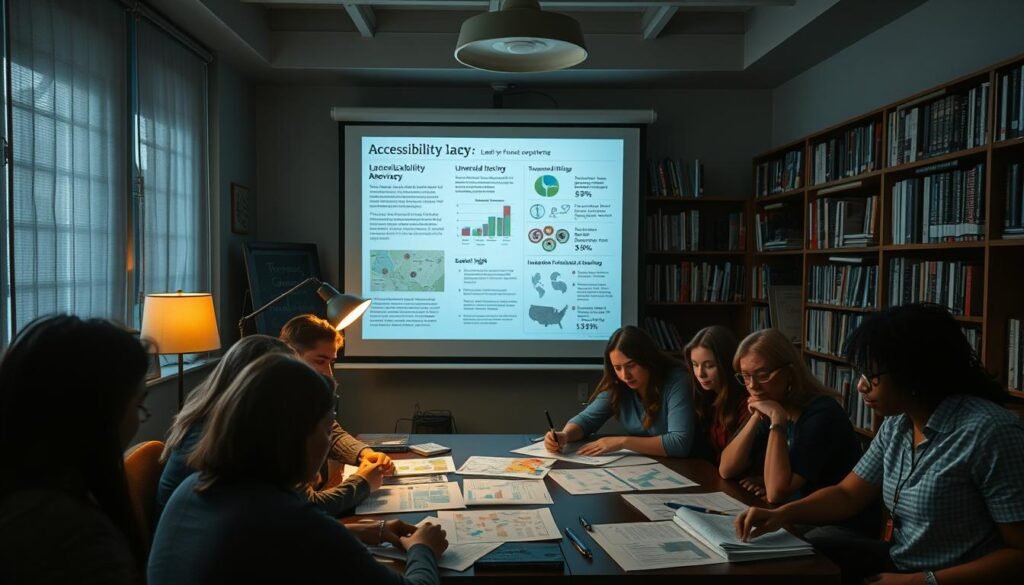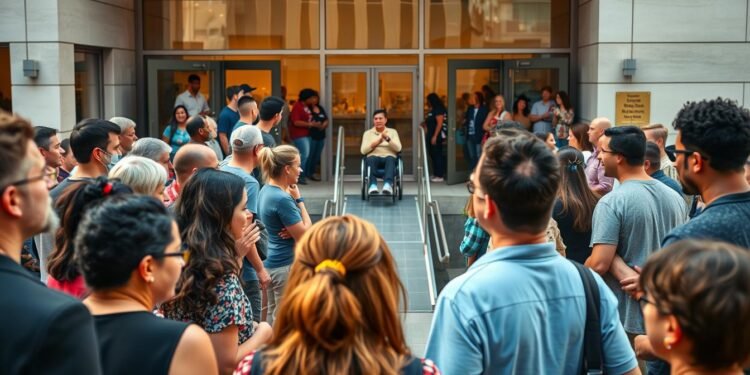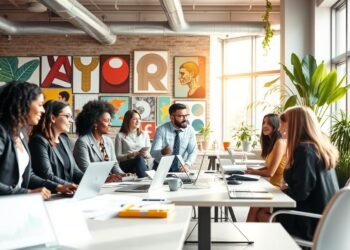What if the biggest barrier facing people with disabilities isn’t physical, but societal? Over 1 billion individuals worldwide live with some form of disability. They face daily challenges that many never consider.
This represents 15% of our global population. Their struggle for equal rights and opportunity affects us all. True inclusion creates stronger communities and drives innovation.
When we break down barriers, everyone benefits. We build a world where every person can contribute fully. This article explores how we can create this positive change together.
Key Takeaways
- Over 1 billion people worldwide live with disabilities
- Disability affects 15% of the global population
- Inclusion benefits entire communities and societies
- Breaking barriers drives innovation and economic growth
- Everyone has a role in creating accessible environments
- Small changes can make significant impacts
- Advocacy creates more equitable systems for all
Introduction to Accessibility Advocacy
Standing up for basic human dignity forms the core of all meaningful advocacy work. When it comes to disability, this means fighting for equal rights and fair treatment. It ensures every individual gets the same chances in life.
This effort takes many forms. Some people speak up for themselves. Others push for better policies in government or business. Many groups work full-time to break down barriers.
History shows us the power of collective action. The Americans with Disabilities Act became law because individuals demanded change. This landmark legislation protects millions of citizens.
Over one billion people worldwide live with various disabilities. They represent a significant part of our global population. Their daily challenges often go unseen by the majority.
Many face prejudice in their workplace or school. Others struggle with physical spaces not built for them. Digital content often lacks proper design for all users.
These obstacles affect health, opportunity, and overall well-being. Addressing them requires awareness and action from everyone in society. Small efforts can create big improvements.
Supporting the disability community benefits us all. It builds stronger, more inclusive communities. Everyone gains when we remove unnecessary barriers.
Understanding Accessibility Advocacy and Its Importance
Every person deserves equal access to opportunities regardless of physical or cognitive differences. This fundamental right drives the movement toward full participation in society.
Defining Accessibility Advocacy
Accessibility advocacy represents the active support for equal rights and opportunities. It works to remove barriers that prevent full participation.
This effort challenges harmful stereotypes about people with disabilities. It promotes understanding through education and awareness campaigns.
Advocates push for fair treatment in all areas of life. They ensure laws like the UN Convention on the Rights of Persons with Disabilities get implemented properly.

Why Advocacy Matters for People with Disabilities
Support matters because it ensures access to critical resources and protections. Without it, many individuals face unnecessary limitations.
This work creates more inclusive education systems and fair workplace practices. It pushes for physical spaces that accommodate everyone’s needs.
Quality of life improves through better healthcare access and assistive technologies. Personal growth opportunities become available to more people.
Society benefits from greater economic productivity when more people can participate fully. Features like ramps and elevators help everyone, not just those with mobility challenges.
We must remember that disability can affect anyone at any time. Making assumptions prevents us from finding common ground and building empathetic communities.
Key Ways to Get Involved in Accessibility Advocacy
Everyone can contribute to building a more inclusive world through practical steps. These actions help create fair systems for all individuals.
Your participation matters regardless of your background or experience level. Small efforts combine to make significant change.
Educate Yourself on Disability Rights and Experiences
Learning forms the foundation of effective support. Start with memoirs like “Being Heumann” by Judy Heumann.
Watch documentaries such as “Crip Camp” on Netflix. Listen to podcasts like “Barrier Free Futures.”
Visit organizations like Atlantis Community in Denver. Share these resources with friends to spread awareness.
Amplify Voices on Social Media
Follow disabled creators to learn from their experiences. Support voices like @theseatednurse and @woodybelfort on Instagram.
Share their content to combat ableism. Engage with their posts to promote inclusivity.
This simple action helps center authentic perspectives. It creates more diverse online communities.
Connect with Disability-Focused Organizations
Local groups need volunteer support and resources. Connect with Colorado Cross-Disability Coalition (CCDC).
Reach out to Mosaic or Easterseals Colorado. The Arc provides numerous engagement opportunities.
Your involvement makes direct impact in your community. Even small contributions help their important work.
Stay Informed on Policies and Legislation
Understand laws like the ADA and IDEA. Follow the Affordable Care Act’s provisions for healthcare access.
Monitor current issues through ACLU updates. Check Disability Rights Education & Defense Fund (DREDF) resources.
Knowledge helps you advocate for better policies. You can push for more inclusive legislation.
Make Inclusion Part of Everyday Life
Check physical spaces for basic access features. Ensure proper communication accommodations like ASL interpretation.
Provide captions for video content. Speak up when you notice barriers in your workplace or community.
These daily actions create lasting change. They make our society more welcoming for all people.
The Role of Education and Awareness in Advocacy
Knowledge serves as the foundation for meaningful progress in creating inclusive environments. When we understand the experiences of people with disabilities, we can better support their rights and needs.
Education breaks down stereotypes and builds empathy. It helps us recognize barriers that might otherwise go unnoticed. This awareness drives positive change in our communities.
Recommended Resources for Learning
Stay current with newsletters from Disability Scoop and ADA National Network. PASCO provides updates on events and legislation affecting the disability community.
Emily Ladau’s book “Demystifying Disability” offers accessible insights for all readers. It serves as an excellent starting point for understanding daily challenges.
These resources help anyone learn about disability rights and experiences. They provide practical knowledge for supporting inclusion efforts.
Starting Conversations About Disability Inclusion
Share interesting articles or podcasts during casual conversations. Recommend resources to friends and colleagues when appropriate.
Discuss what you’re learning during family meals or coffee breaks. These natural exchanges spread awareness without formal settings.
Form book clubs to explore works by disabled authors. Watch documentaries like “Crip Camp” with groups and discuss them afterward.
Follow social media hashtags like #DisabilityVisibility and #accessibility. Engage with content from disabled creators to gain firsthand perspectives.
These conversations create more understanding systems in our society. They help build a world that values every individual‘s contribution.
Advocacy in Healthcare and Media Representation
Healthcare systems and media platforms play pivotal roles in shaping societal perceptions of disability. Both areas significantly impact how people with disabilities experience daily life and participate in community activities.
Improving these sectors creates more equitable systems for all individuals. Small changes in language and representation make substantial differences in quality of life.
Improving Healthcare Inclusivity
Language choices in medical settings significantly impact patient experiences. Using terms like “wheelchair user” instead of “wheelchair bound” reduces stigma.
This respectful terminology acknowledges individual ability rather than limitation. It represents an important mindset shift in healthcare practice.
Patients should lead their healthcare teams with providers offering options and support. This collaborative approach ensures better decision-making and outcomes.
Physical spaces must meet ADA standards with proper ramps, elevators, and accessible equipment. Cultural accessibility matters equally through improved specialist communication.
Including people with disabilities in healthcare communities provides vital insights. Students, trainees, and staff with lived experience help identify needs.
Their participation creates more inclusive workplace environments and better patient care. Everyone benefits from diverse perspectives in medical settings.
Accurate Media Representation of Disability
Media portrayal significantly influences public understanding of disability. Currently, only 4.2% of TV and film content features characters with disabilities.
This disparity exists despite 26% of U.S. adults identifying with some form of disability. The representation gap affects societal perceptions and awareness.
Recent progress shows more disabled actors and creators in mainstream features. Authentic representation presents disability as one aspect of multidimensional characters.
These relatable portrayals help audiences see people first rather than conditions. They break down stereotypes and build understanding across communities.
Supporting authentic media through social media engagement promotes positive change. Consuming content with accessibility features like captions reaches wider audiences.
These actions encourage producers to create more inclusive entertainment. They demonstrate that accurate representation matters to viewers.
The Global Impact of Accessibility Advocacy
Across continents, millions face barriers that limit their full participation in daily life. These obstacles affect education, employment, and social connections. Global efforts address these issues through coordinated action and shared goals.
International cooperation creates momentum for meaningful progress. It helps establish standards that benefit all nations. This worldwide movement transforms lives and communities.

Challenges Faced by People with Disabilities Worldwide
Social stigma remains a significant hurdle for many individuals. Negative stereotypes create prejudice in various settings. This affects mental health and self-esteem.
Employment discrimination limits economic opportunities. Many qualified candidates face biased hiring practices. Educational systems often lack proper accommodations.
Physical spaces frequently present obstacles. Inadequate ramps, narrow doorways, and poor signage create barriers. Digital platforms sometimes exclude users through poor design.
Public transportation systems may not accommodate all needs. This restricts mobility and independence. These challenges vary across regions but share common themes.
Benefits of Advocacy for Society
Inclusive practices boost economic productivity significantly. When more people can work, economies grow stronger. Businesses gain access to diverse talent and perspectives.
Universal design features help everyone in the community. Ramps assist parents with strollers and elderly individuals. Clear signage benefits visitors and residents alike.
Stronger communities emerge through empathy and understanding. Diversity creates richer social connections. Mutual respect becomes the foundation for collaboration.
Global engagement through policy support creates lasting change. International standards raise quality of life everywhere. Cross-border cooperation addresses common challenges effectively.
Everyone benefits when we create more inclusive environments. Small adjustments make big differences in daily life. Our shared humanity connects us across all boundaries.
Conclusion
Building inclusive communities starts with recognizing that every person’s contribution matters. Our collective efforts create lasting change for people with disabilities.
Simple actions make significant impacts. Share resources with a friend or post on social media. These steps expand awareness and support.
Every action builds toward equal rights and opportunity. Your involvement creates more inclusive systems and spaces.
Join this important movement today. Together, we can remove barriers and ensure everyone thrives in our society.
FAQ
What is accessibility advocacy?
Accessibility advocacy is the effort to promote equal rights and opportunities for people with disabilities. It involves working to remove barriers in society, such as those in physical spaces, digital platforms, and social attitudes.
Why is advocacy important for people with disabilities?
Advocacy is crucial because it helps ensure that individuals with disabilities can participate fully in all aspects of life. It challenges discrimination and pushes for policies that support inclusion, dignity, and independence.
How can I get involved in accessibility advocacy?
You can get involved by educating yourself on disability rights, supporting organizations that focus on disability issues, using social media to raise awareness, and advocating for inclusive policies in your community or workplace.
What are some recommended resources for learning about disability inclusion?
Great resources include websites like the World Health Organization, the Americans with Disabilities Act National Network, and disability-led organizations such as the National Council on Independent Living. Books, documentaries, and online courses also offer valuable insights.
How does advocacy impact healthcare for people with disabilities?
Advocacy improves healthcare by pushing for more accessible facilities, better communication between providers and patients, and policies that address the specific health needs of the disability community. It helps ensure equitable and respectful care.
What role does media representation play in accessibility advocacy?
Accurate media representation helps break down stereotypes and promotes understanding. When people with disabilities are portrayed authentically, it fosters empathy and supports broader social inclusion and acceptance.
What challenges do people with disabilities face globally?
Common challenges include limited access to education, employment, healthcare, and public spaces. Social stigma, inadequate policies, and economic barriers also significantly impact their quality of life in many parts of the world.
How does advocacy benefit society as a whole?
Advocacy creates a more inclusive world where everyone can contribute and thrive. It leads to innovative solutions, stronger communities, and economic growth by ensuring that no one is left behind due to disability.





